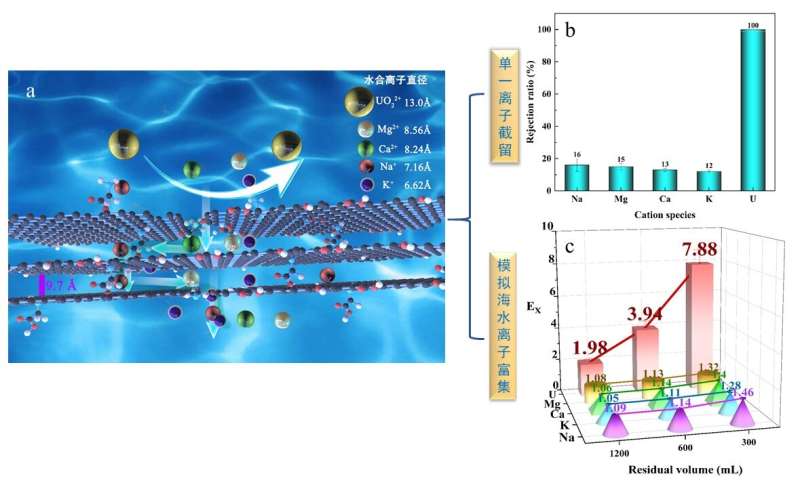New method to enrich uranium in seawater

Researchers at the Institute of Modern Physics (IMP) of the Chinese Academy of Sciences (CAS) have developed an innovative method of pre-enriching uranium in seawater by membrane filtration.
Uranium is the vital source for nuclear power generation. There are about 4.5 billion tons of uranium existing in seawater, which is 1,000 times more than terrestrial reserves. However, the extremely low uranium concentration and huge amounts of coexisting ions, especially K+, Na+, Ca2+ and Mg2+, makes the extraction of uranium from seawater very challenging. Thus, it is of great importance to enrich uranium and reduce the concentration difference between uranium and the main coexisting ions.
In a study published in the Chemical Engineering Journal, based on the prominent hydrated ion diameter differences between UO22+ and the main coexisting ions, the researchers have developed an effective method to pre-enrich uranium in seawater. They fabricated a new type of glycine cross-linked composite graphene oxide (GO-Gly) membrane with good ion sieving properties, which can meet the demands of uranium pre-enrichment in seawater.
According to the researchers, the cross-linking of GO by glycine not only overcomes the swelling defect of GO membrane in solution, but also fulfills the requirement for the channel size of uranium separation from the main coexisting ions. Moreover, the structure of the membrane can keep stable when immersed in water solution for a long time.
Then the researchers investigated the ion rejection and enrichment properties of uranium and the main coexisting ions in single ion solutions and simulated seawater, respectively. It was found that almost 100% of uranium was rejected by the GO-Gly membrane. In addition, only uranium was obviously enriched while the concentrations of the main coexisting ions kept nearly constant in continuously filtrating the simulated seawater with the membrane.
The results confirm that the GO-Gly membrane is an ideal candidate for uranium pre-enrichment in seawater. This new method combined with the traditional methods is expected to greatly improve the uranium recovery efficiency and promote the real application of uranium resources in seawater.
More information: Jian Chu et al, Enrichment of uranium in seawater by glycine cross-linked graphene oxide membrane, Chemical Engineering Journal (2022). DOI: 10.1016/j.cej.2022.136602
Provided by Chinese Academy of Sciences



















